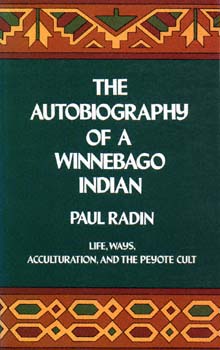
BACK COVER #
"The Autobiography of a Winnebago Indian," edited by Paul Radin, has long been one of the great classics in American anthropology. Originally taken down in the field, in Winnebago, from the dictation of the Indian known as S.B., it relates S.B.'s life as he looked back upon it: with the emphases, interpretations, and values that he considered important. Dr. Radin, without altering the text, translated it into English and annotated it extensively to explain features of Winnebago culture and outlook that might not be obvious to the reader.S.B. led a remarkable life. He was born in the second half of the 19th century, when the older Indian life-pursuits and the white man's world were beginning to clash badly. He tells of his experiences in the hunt, the instructions he received from his elders in Indian life, the work of his brother-in-law the shaman, adolescence, initiation into the Medicine Dance, marriage and sexual promiscuity, entry into the white man's world when he travels with a circus, alcoholism, desire to count coup and the ensuing murder of a Pottawattomie, trial and jail, and his release upon a technicality. After this crisis occurred his experiences with the peyote cult, which offered a new life for him: his acquaintance with members, his trial of peyote, strange visions, conversion and a new way of life. Apart from its anthropological value, S.B.'s autobiography is most significant to other social scientists, and fascinating reading even for laymen. Its curious mixture of insight and naivete, its exciting events make it a very unusual book.
S.B.'s autobiography was written during an important moment in American Indian history, when traditional Winnebago standards were in process of collapse, and more positive aspects of acculturation had not yet emerged. It is significant for Mr. Radin's prophetic scholarship that he prepared this study of an evolving society and personality at a time when most anthropologists were concerned with the isolation of static, ideal primitive societies. Also extremely important to the scholar is a 22-page chapter of folkways based upon the instructions given by the tribal elders. These points cover the Winnebago religion, social etiquette, the function of "medicine," marriage and sex, precepts for women, and the wisdom of the old men.


